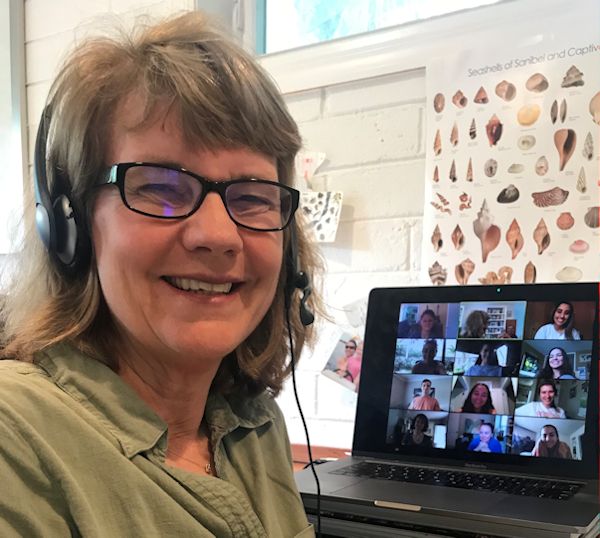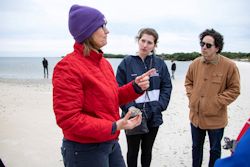SEJournal Online is the digital news magazine of the Society of Environmental Journalists. Learn more about SEJournal Online, including submission, subscription and advertising information.
 |
| Author Cynthia Barnett, environmental journalist-in-residence at the University of Florida, above, using Zoom in March to teach students spread across Florida but still working on their semester project on public health and climate change. Click to enlarge. |
EJ Academy: In Days of Social Distancing, Getting the Goods … Virtually
Editor’s Note: This special edition of the quarterly EJ Academy is being published just three weeks after our previous regularly scheduled March 25 column on the challenges and opportunities of teaching during the COVID-19 pandemic. The feature is brought to you by SEJournal Online and EJ Academy editor Bob Wyss as a response to the critical need for information and context in this difficult time. Additional columns on covering COVID-19 can be found on SEJournal’s main index page. Plus, visit SEJ.org for a growing list of COVID-19 resources for journalists.
By Cynthia Barnett
Freelance journalist Dan Zukowski opened his story on the potential reintroduction of wolves in Japan with a panoramic view from 5,500 feet:
“From the peak of Mt. Rausu, a clear view of the Shiretoko Peninsula opens from the Okhotsk Sea on the west to the Pacific Ocean on the east. Below, a dense green boreal forest of conifers, maples and birch hides hundreds of brown bears and 590,000 sika deer. Japanese wolves once roamed this wilderness but their primeval howls fell silent here, and throughout Japan, more than a hundred years ago.”
Zukowski actually reported his story, which ran in Mongabay and Pacific Standard, from a 74-foot rise in a new development in Portland, Maine, his home office window overlooking red and yellow fall foliage blended into an evergreen forest of tall white pines. (See what I did there?)
As the University of Florida and others have
shifted courses online, the challenge for me is
not the virtual classroom, but the virtual reporting.
My environmental journalism course at the University of Florida has a mantra: “Get your boots muddy.” As UF and others have shifted courses online, the challenge for me is not the virtual classroom, but the virtual reporting.
Student reports must now ‘phone it in’
We spend the first half of the semester on immersive environmental journalism. During a weekend on a remote barrier island, we practice field notes and interviews with locals who often dispel students’ notions about rural culture and the environment. On a nature-writing scavenger hunt, students describe smells and the quality of light.
All of this leads up to a class project they are expected to report in person and file with narrative detail.
But the spring EJ students had just finished their pitches on the project when the university sent them home.
 |
| The author with students in February, during an immersive reporting field trip on the Gulf of Mexico barrier island of Seahorse Key. Photo: Courtesy Cynthia Barnett. Click to enlarge. |
In our Zoom classroom, I’m walking back my admonition — “Don’t phone it in” — and teaching what I have to admit comes closer to reality: While immersion is a great way to teach our craft and a privilege for those of us with travel funding, day-to-day reporting looks more like Zukowski’s.
A freelance journalist specializing in environment and transportation, Zukowski published 70 pieces last year. He landed a travel budget for exactly one. A few others he reported in person because either the sources were local or he could combine the interviews with a personal trip.
Zukowski crafted his Mt. Rausu lede by Skyping with a scientist who had hiked the peninsula and getting him to describe the landscape in detail. Google Photos and Instagram amass hundreds of photos of almost any point in the world, helping reporters describe landscapes in different weather, light, seasons or times of day. Google Maps, Earth and Street View can all help evoke a sense of place.
I frequently tap historic weather data from the National Centers for Environmental Information (formerly the National Climatic Data Center) to help me describe a day. I recently asked the captain of a research vessel to check his log for the conditions on the night when the dredge pulled up a secretive mollusk I was writing about.
Animals, even endangered ones, have been recorded in countless hours of video often posted to YouTube, allowing us to hit play over and over to finesse a physical description or behavior. I also use YouTube to watch lectures or science café talks by researchers before I interview them, which can inspire a physical description or a quirky personal detail.
Imaginative observation approaches possible
Reporting-by-app can’t replace physical immersion. But, constrained by deadline, tight budgets or a global pandemic, it can make up for observation — one of the core skills we teach in environmental reporting alongside interviewing and research.
Author and photojournalist Michael Kodas has his students think about these fundamentals (observation, interviewing and research) as a three-legged stool: When one leg is weak — in the coronavirus emergency, the weak leg is observation — he leans on the other two.
Reporting-by-app can’t replace physical immersion.
But, constrained by deadline, tight budgets or a
global pandemic, it can make up for observation.
To write scenes for his book “Megafire” that he didn’t observe, Kodas, former deputy director of the Center for Environmental Journalism at the University of Colorado in Boulder, studied the behavior of particular wildfires in scientific articles and other documents. He then used his grasp of the details to walk interview subjects through their own experiences. The result is cinematic.
Student journalists can also excel in social media mining. At Emerson College, journalism professor Doug Struck marveled at a student’s riveting narrative of a young woman’s fight to endure five surgeries and run the Boston Marathon. The story was full of detail and dialogue, verbatim conversations with doctors, and even the runner’s thoughts, displayed in time and distance as she trudged 26 miles in the rain.
Struck asked the reporter, Nicole Ryan, how much time she’d spent immersing. None to speak of. The 20-something patient had documented her hospital stay, recorded her conversations with doctors, parents and others, and logged her 26-mile run, all on her smartphone. Ryan mined still more with the help of Instagram, Twitter and Facebook posts.
Immersive-phoner tips
As cell and Skype interviews become ever-more crucial for social distancing, we could all use a refresher on how to get the goods by phone.
For instance, Eugene, Ore.-based science writer Valerie Brown spends an average hour on telephone interviews; sometimes it takes the first half hour to establish trust. Once she gets her sources talking, the conversation often turns more relaxed and colorful — that is, more quotable. And it should be a conversation, like the master Studs Terkel used to say, not an interview.
Some other immersive-phoner tips:
- Asking for a quirky detail can be a fun way to break the ice: “What’s the most surprising thing in your office related to your work? Is it possible to show it to me on the video?”
- Ask “what” questions, which are less likely to lead to dead-end yes or no answers: “What did you do next?” “What was going through your mind just then?”
- Like Kodas, encourage your source to retell the story: “Take us back to that moment.” If they leave out something you’re curious about, gently interrupt with follow-up questions. Keep asking why.
- Radio reporters are great at getting sources to reveal detail, even at a distance. Freelancer Karen Shaefer, for instance, suggests this tack: “Describe to me what it looks like outside your window right now (or whatever you’re trying to glean). Compare what you see now to what you would normally see.”
Virtual reporting cannot come close to face-to-face interviews or immersing with our subjects to tell the most-powerful stories and uncover the most-obfuscated.
A world of high carbon emissions and tight budgets means we should phone it in when we can — or when we must. But ultimately, the more time with subjects, the richer the stories — just like the more time with students, the richer the teaching.
I hope I get to see their muddy boots again soon.
Cynthia Barnett, an occasional SEJournal contributor, just finished her fourth book, a story of seashells and the mollusks that make them. She is environmental journalist-in-residence at the University of Florida’s College of Journalism and Communications.
* From the weekly news magazine SEJournal Online, Vol. 5, No. 15. Content from each new issue of SEJournal Online is available to the public via the SEJournal Online main page. Subscribe to the e-newsletter here. And see past issues of the SEJournal archived here.

















